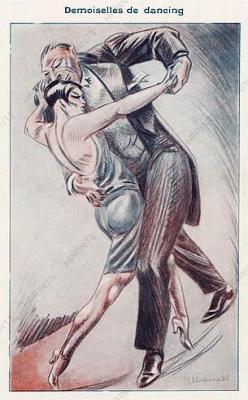Argentine Tango - Then and Now

This post has been prompted by multiple comments on videos I have put on YouTube of social dancers from the 1930s - comments like a dance that was clearly identified as a Fox Trot at the time was not, in fact a Foxtrot; and the Tangos in a 1931 Argentine movie called "Tango", were not "real" Tango.
This sort of thing makes me a bit grumpy. There is a strong tendency for dancers to define the "correct" or "real" style of a dance as "The style I was taught". If I have learned nothing else in my years of delving into the primary sources for 19th & 20th Century social dances, it's that when a dance is widely popular and danced over a period of many years by people all over the globe; there will be infinite variety. Even if some self-appointed "experts" (I'm looking at you Arthur Murray) may call one thing "correct" and another "incorrect", what indeed is the "correct" way to dance a dance?
It is really one of my pet peeves in trying to recreate the dances of the Jazz Age is our tendency to extrapolate how we dance today into the past: to say "I know the Foxtrot, so this must be how it was done in 1930" or to say "The Tango is eternal and never changing".
I want to be clear that I am not condemning current dance styles. They are a reflection of our current interests and sensibilities - just as the dances of the Jazz Age reflected that era's very different interests and sensibilities. Societies evolve and dances evolve with them, and all that I ask is that we try not to superimpose our current view of things on the past.
I will use the Argentine Tango as an illustration of my point, but the same evolution has occurred with the other current ballroom dances: the Foxtrot, Waltz and Quickstep.
One of the biggest differences between then and now is our current blending of theatrical "exhibition dancing" and social dancing - current social dancing tends to be an almost apologetically watered down version of the exhibition style, but containing as many fancy moves as one can muster.
Back in the day, social dancing was a simpler affair, with a focus on partner interaction and very little on outward display, and exhibition dancing was a distinctly different style with a completely different purpose. There was a clear and conscious separation of "Exhibition Dancing" (think Fred and Ginger) and "Ballroom (i.e. Social) Dancing". If you look at a film of the Coconut Grove in 1938, no one is trying to dance like Fred Astaire.
Which is why I find this first clip so interesting. Carlos Gardel (the King of the Tango) is dancing and everyone stops dancing to watch - not because Carlos and his partner are so flashy and spectacular, but because their dance has a level of focus and precision that the audience understands and appreciates. Note the total lack of kicks. Also, look at all the background dancers, doing their ordinary, work-a-day Tangos.
This is followed by current Argentine Tangos as danced to amuse the tourists on the streets of Buenos Aires - admittedly theatrical since they are putting on a show, but still very much what most people today expect to see when they see a Tango - and feel like they're not quite getting it right if they don't dance it this way.
This is then followed by "The Argentine Tango": a 1930s exhibition Tango such as you would see in a night club.
It's probably not necessary to watch each of the clips all the way through to get the gist of what I'm talking about.
Here's the first, from the Argentine film "Questo Abajo"
And here are dancers showing off for the tourists.
And here are exhibition dancers from 1930. I find it interesting that they are theatrical in a completely different way than current exhibition dancers are theatrical - they have a very different sensibility, smoother and more romantic and without the violent, sudden motions that are now the norm.
